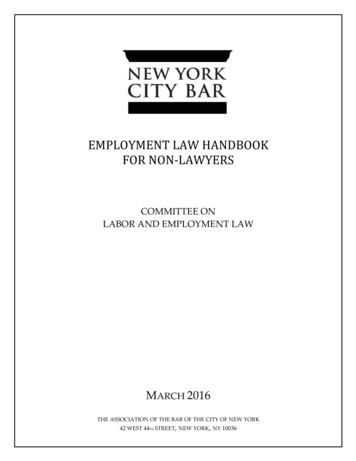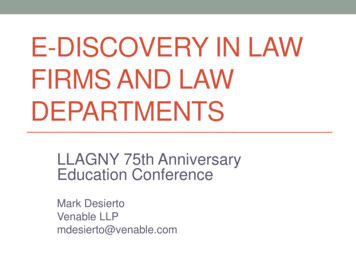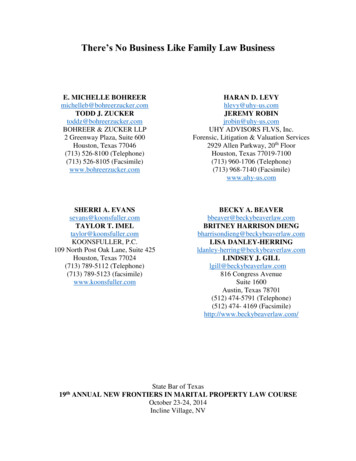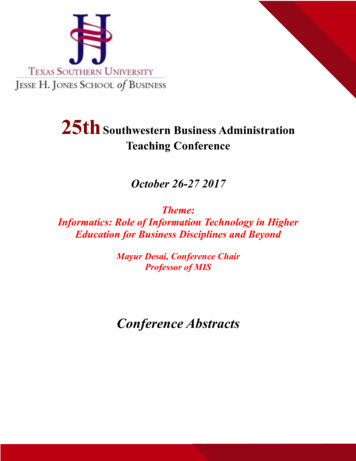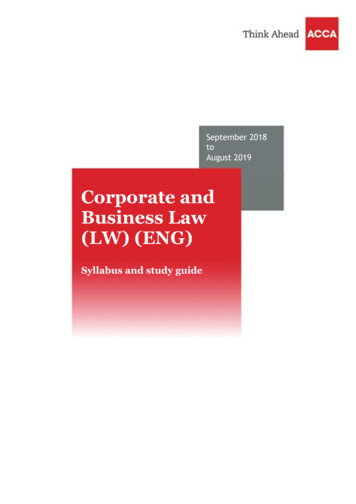
Transcription
Journal of University Teaching & Learning PracticeVolume 11 Issue 22014Teaching Business Law to Non-Law Students,Culturally and Linguistically Diverse (‘CaLD’)Students, and Large ClassesKanchana KariyawasamGriffith University , Australia, k.kariyawasam@griffith.edu.auHang Yen LowGriffith University, Australia, h.low@griffith.edu.auFollow this and additional works at: http://ro.uow.edu.au/jutlpRecommended CitationKariyawasam, Kanchana and Low, Hang Yen, Teaching Business Law to Non-Law Students,Culturally and Linguistically Diverse (‘CaLD’) Students, and Large Classes, Journal of UniversityTeaching & Learning Practice, 11(2), 2014.Available at:http://ro.uow.edu.au/jutlp/vol11/iss2/9Research Online is the open access institutional repository for theUniversity of Wollongong. For further information contact the UOWLibrary: research-pubs@uow.edu.auArticle 9
Teaching Business Law to Non-Law Students, Culturally and LinguisticallyDiverse (‘CaLD’) Students, and Large ClassesAbstractThis paper is largely based on the experience of teaching law to students with non-legal background inbusiness schools, with a focus on internationalisation and the large class lecture format. Business schools oftenconsist of large classes which include a significant proportion of Culturally and Linguistically Diverse (CaLD)students. Teaching a difficult and demanding subject to a large cohort of students from increasingly diversebackgrounds can be an onerous task. The existence of these conditions present different teaching challengesand requires a re-examination of teachers’ approaches to student learning.In this article, the experience of teaching law in business schools is approached through an examination of thechallenges and problems arising from (a) teaching law to non-law students (b) teaching CaLD students (c)teaching large classes. At each stage, the writers explore effective solutions and strategies to deal with theseissues.KeywordsBusiness Law, CaLD students, Large classesThis journal article is available in Journal of University Teaching & Learning Practice: http://ro.uow.edu.au/jutlp/vol11/iss2/9
Kariyawasam and Low: The Teaching of Business Law to Non-Law StudentsIntroductionBoth graduate and undergraduate business schools in many Australian universities includemandatory law subjects in their programs, as required by various professional bodies such as CPAAustralia (CPA Australia is one of three professional accounting bodies in Australia, the othersbeing the Institute of Public Accountants and the Institute of Chartered Accountants of Australia).Clearly, students who choose to study law have a genuine interest in the subject. However,students who study law as incidental to their degree do not necessarily have the same intrinsicinterest in it. (Ownes & Wex 2010). In fact, non-law students often find the obligatory study oflaw to be a daunting and perhaps unwelcome experience (Ownes & Wex 2010). They feeloverwhelmed by the amount of reading required (Allen 2007) and often struggle to understand thebroad legal principles and terminology.The challenge is further magnified when the student cohort is large and diverse, as is often thecase. Larger class sizes with mixed student cohorts present significant teaching challenges in termsof the quality of teaching, assessment of student learning, course administration and provision oftimely and effective feedback on students’ work. Like many other countries, Australia is becomingincreasingly multicultural. It is the third-most popular study destination in the English-speakingworld, and over 200,000 international students are enrolled in Australian institutions across thehigher-education sector (Australian Education International Data 2009). For example, the morethan 27,000 students at Griffith University in Queensland, one of Australia’s leading universities,include 4,000 students from over 80 nations (Woods, Barker & Hibbins 2010). Universities withlarge numbers of international students face significant cross-cultural challenges, and must lookclosely at their teaching and learning strategies if they are to cope with increasinginternationalisation (Muzychenko 2007). While having a large number of international studentsmay appear to increase the cultural diversity within universities, it only does so if that diversity isvalued and incorporated into the university curriculum (Das 2005). Otherwise, it simply adds to arange of problems for international students, who are trying to fit into an educational system thatdoes not recognise their own culturally based ways of knowing, learning and expressing theirknowledge (Goold, Craig & Coldwell 2007). In particular, students from diverse backgroundsmust be initiated into the context in which they will be expected to learn. These students may havedifferent expectations of teachers and of their own role as students. Teachers in culturally diverseinstitutions, therefore, must reexamine their approach to student learning.This paper begins with a discussion of some of the challenges and obstacles encountered whenteaching law to students from non-legal backgrounds. It suggests that non-legal students require adifferent legal curriculum, a variety of integrated formative assessment methods and differentpedagogy from that offered to pure law students. Following this, the paper discusses theimportance of adapting effective teaching methods to address the challenges encountered in largerclasses comprised of culturally and linguistically diverse (CALD) students. The views and ideaspresented in this paper are based on the experience of teaching Introduction to Business Law andCompany Law courses to undergraduate business students in the Department of Accounting,Finance and Economics, Griffith University.1
Journal of University Teaching & Learning Practice, Vol. 11 [2014], Iss. 2, Art. 9Teaching Law to Business Students: The ChallengesLegal educators teaching in business schools play an important role in preparing business studentsfor the commercial world, but the task is not an easy one. Many of the challenges and problems gobeyond those encountered by law lecturers in law schools. This section discusses the primarychallenges arising in teaching law to non-law students.Differing CharacteristicsLaw students often attend law schools with certain pre-existing attitudes, personalities, qualities,interest, values and ethics. In particular, law students typically come to law schools with welldeveloped linguistic skills, an aptitude for reading and writing and a disposition to work hard.These comments will appear rather commonsense when one considers the challenges and rigorousdemands of law courses, including reading large volumes of text-based materials. Although manyfirst-year law students, like students in business schools, have no prior experience of studying law,law students tend to be already equipped with the core skills to successfully learn law. Since lawstudents and non-law students are different in various aspects, a law teacher who is delivering alegal education to business students should never assume that the required learning outcomes canbe achieved by using the same course model, teaching styles and strategies as those adopted toteach law students. It has been argued that the characteristics of students should be taken intoaccount in the design of teaching strategies (Johnstone 1996).Isolation and DetachmentWhen non-law students are studying law for the first time, they usually feel nervous, perceive thatlaw is an extremely difficult subject and doubt their abilities to successfully grasp the subject.Very often, even if they have studied a law course in previous semesters, they carry this perceptioninto the next law course they study, as they may have felt disconnected from their teachers in thepast. They may also fail to understand the relevance of the law they are studying to their futurecareer in business. These elements create an environment that reduces teaching effectiveness.From the teacher’s perspective, certain things could be done to put the non-law students at easewith the legal materials and foster a greater connection between these students and their teacher.Problems with Content, Learning Outcomes and ResourcesStudying a law course naturally involves a heavy workload; in the case of non-law students, thisproblem is more acute. Business students often complain about “too much law in too little time” –a common concern expressed by other law lecturers who teach non-law students (Owens & Wex2010). Law lecturers teaching non-law students are faced with great difficulty in determining theright level of legal content to include in the course. For example, in the Bachelor of Commerceprogram offered by the Griffith Business School, one of the core modules is “Introduction toBusiness Law”, which covers topics such as the Australian legal system, contract law, consumerprotection law, tort law and agency and partnerships over 13 weeks. However, some of thesetopics, such as contract law and tort law, are typically covered in an entire semester in lawschools. On the one hand, there is a practical issue involved where the lecturer needs to limit thescope of these topics so that they can be taught over a short period of time. On the other hand, thelecturer has to ensure that the students in the course have a deep enough understanding of the lawto benefit them in their future careers, and that the course content meets the standards andeligibility requirements of the relevant accreditation body (for accredited courses). Similarly, thelaw lecturer will find it challenging to set the learning outcomes of the course, since businessgraduates are not required to have the same professional legal skills as law graduates and do not“need to know” as much law.http://ro.uow.edu.au/jutlp/vol11/iss2/92
Kariyawasam and Low: The Teaching of Business Law to Non-Law StudentsIn addition, the law lecturer will encounter difficulties in finding reading resources (particularlytextbooks) appropriate for business students (Skwarok 1995). It is particularly important that nonlaw students find the reading materials enjoyable, stimulating and relevant to their chosen courseof studies, and that the materials allow them to learn independently outside the classroom(Johnstone 1996). Although the availability of literature customised for the needs of non-lawstudents is gradually increasing, a substantial number of textbooks are still designed specificallyfor law students, who require a more erudite understanding of the subject.Some Solutions and StrategiesA Change in Teaching MethodologyThe black letter law approach (Cownie 2004) and the Socratic method (Dickinson 2009; Bradford1999) are long-standing traditions in law schools. However, the general consensus in the literatureis that these pedagogical methods do not meet the academic and professional needs of non-lawstudents (Endeshaw 2002; Morris 2007; Gerber 2009). Most law lecturers teaching in businessschools were trained in, and are experienced in teaching in, law schools and their characteristicpedagogical methods. The difficulties encountered by the law lecturer are succinctly expressed byone legal academic: “How does the faculty unlearn or modify its learning of the very process thatmade it what it is, and then replace it with something different with which to teach others the samesubject outside the law school?” (Morris 2007). As a result, at the very outset, the authors of thisstudy adopted the notion that we would not be teaching students to study the intricacies of lengthylaw reports and expose them to esoteric legal arguments; instead, we would aim to implementinnovative teaching methods that allow students to acquire a more practical understanding of thelaw for success in the corporate environment. This change of teaching methodology – which mustalso be made clear to the students –not only is in line with the learning objectives of non-lawstudents, but offers the additional psychological benefit of reducing the pressure on and frustrationof business students, who would most certainly be confused and overwhelmed with the difficultiesinvolved with the traditional techniques, none of which would have been previously introduced tothem in their discipline.Innovative LecturesDespite the presence of studies that challenge the effectiveness of lectures and their role in thelearning process (Gower 1950; Pirie 1987; Fritz 2008), this form of teaching is indispensable forcourses with large groups of students because of their cost-benefit ratio. This method of teachingis even more important when transferring legal knowledge to business students, who generallyperform better when the expertise and motivation provided by a professional lecturer is involved,as opposed to the process of self-study, where they will encounter many difficulties inunderstanding the law. Having established that lectures play a major educational role in theteaching of law to business students, it is important to design and deliver effective lectures. Certainstrategies and techniques work particularly well with students from a non-legal background.Flowcharts/FrameworkA flowchart is a very useful visual aid to transform the learning experience of students in thelecture room. The current state of technology makes the process of creating flowcharts a quick andeasy one, or they can be found in law textbooks. For students from a non-legal background,flowcharts can provide them with a quick and pragmatic way to study complex legal concepts and3
Journal of University Teaching & Learning Practice, Vol. 11 [2014], Iss. 2, Art. 9cases. It is easy for students to feel disconnected and lost in voluminous written materials. Noother teaching tool can provide a more concise way of communicating the law and overcomingfeelings of being overwhelmed by the bigger picture. Moreover, flowcharts can illustrate the stepby step process for analysing and answering legal proble
Business Law”, which covers topics such as the Australian legal system, contract law, consumer-protection law, tort law and agency and partnerships over 13 weeks. However, some of these topics, such as contract law and tort law, are typically covered in an entire semester in law schools. On the one hand, there is a practical issue involved where the lecturer needs to limit the scope of these .





